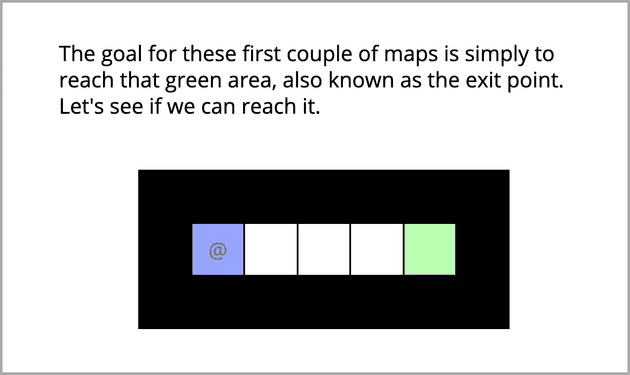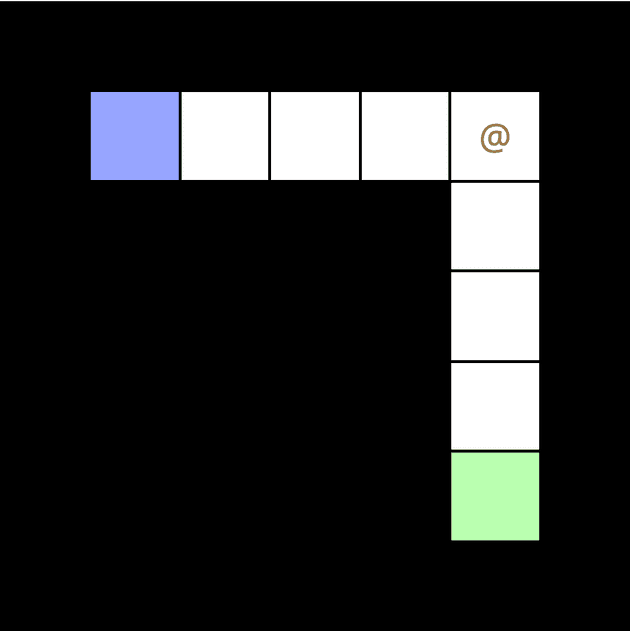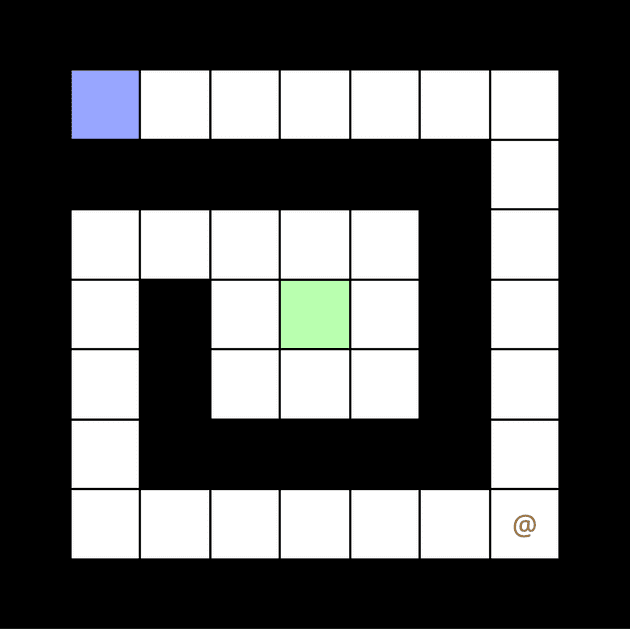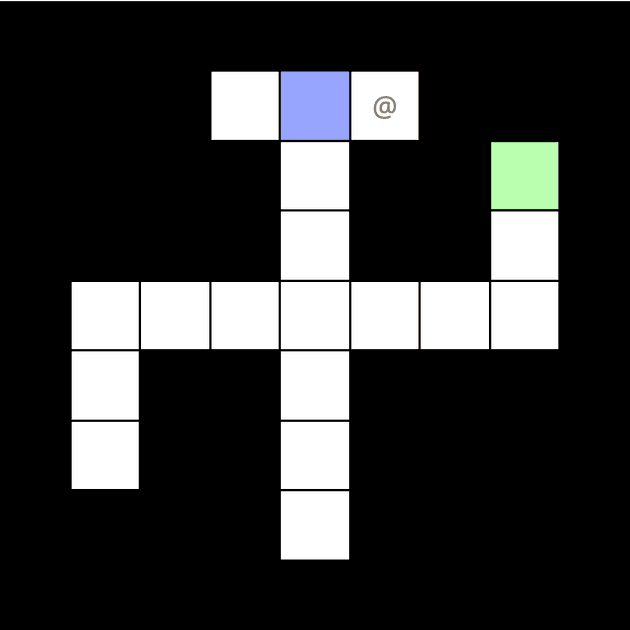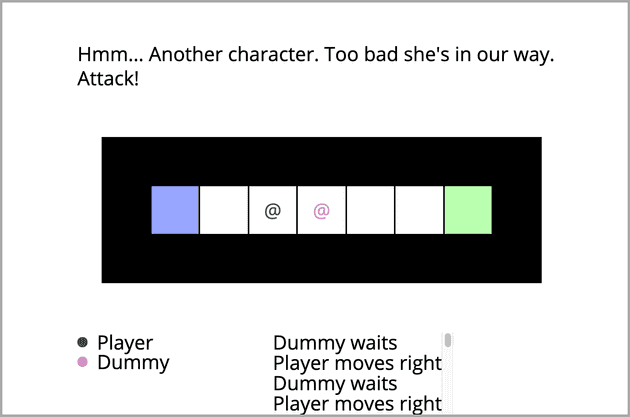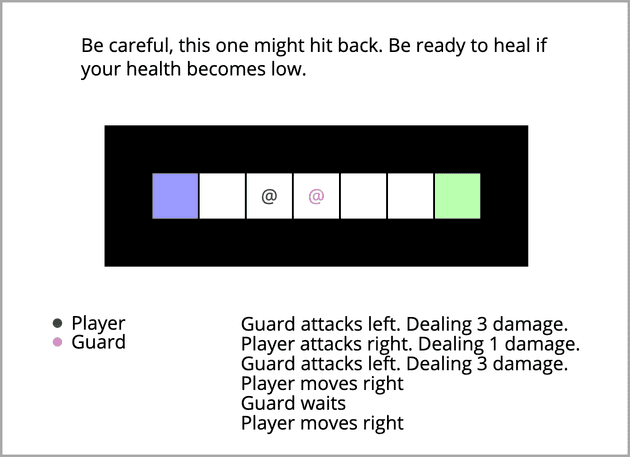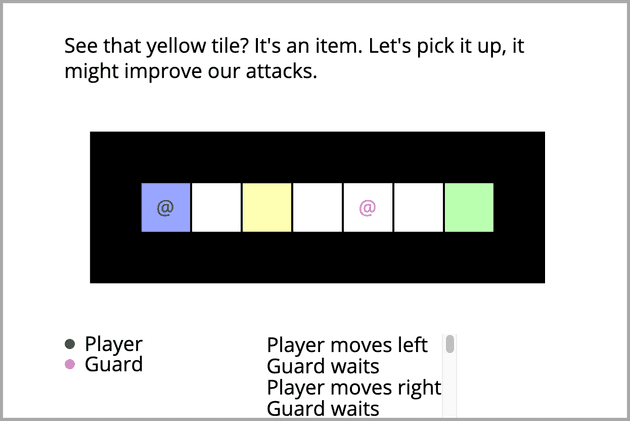I’ve recently bumped into Elm Warrior, an Elm adaptation of Warrior JS. The premise of the game is to write a simple AI that is able to navigate through multiple levels of a dungeon. This is how the first level looks like:
You (the warrior) are represented by the @. You always start on the blue
tile and your goal is to reach the green tile. I thought it would be a cool
idea to write down how to approach solving a problem like this.
Robin recently wrote a great introduction to how to play Elm Warrior and I wholeheartedly recommend reading it if you’re just starting out.
Before we begin, a word of warning…
SPOILERS AHEAD!
SPOILERS AHEAD!!
SPOILERS AHEAD!!!
Now that my conscience is clear, I’ll start by copying the exposed values and functions from each top-level module and pasting them all together in one file. No docs, no type signatures, nothing, just their names. As the sage once said:
Stat rosa pristina nomine, nomina nuda tenemus.
Which roughly translates as:
The rose of old remains only in its name. Only naked names we possess.
Let’s get moving, shall we?
module Warrior exposing
( Warrior, Action(..)
, id, position
, health, maxHealth, healingPotential
, attackDamage, inventory
)
module Warrior.Coordinate exposing
( Coordinate
, toString
)
module Warrior.Direction exposing
( Direction(..)
, all, toString
)
module Warrior.History exposing
( History
, roundsPlayed, previousStates, previousActions
)
module Warrior.Item exposing
( Item(..)
, toString
)
module Warrior.Map exposing
( Map
, look, lookDown
)
module Warrior.Program exposing
( TurnFunction
, Model, Msg
, Config, program
)At this point we clearly don’t understand what is going on with the code, but just by reading this listing a couple of times we are getting familiar with the names of this particular domain. Just let them soak in.
Now I’m getting a tad more curious and will take a look at these exposed
data constructors: Direction, Action, and Item. Whenever a module
exposes the inner contents of a type, that’s an invitation to the world to
depend on those values, so I know it’s going to be useful to take a peek.
type Direction
= Left
| Right
| Up
| Down
type Action
= Wait
| Heal
| Pickup
| Move Direction
| Attack Direction
type Item
= Sword
| PotionThere is a lot of information packed in these simple names, so don’t worry if you feel a bit overwhelmed. Instead, let’s try something practical and look at the first level.
Level I
Let’s start here.
The source on the left hand side reads like this:
main : Program () Program.Model Program.Msg
main =
Program.program
{ maps = Maps.all
, players = [ ( "Player", takeTurn ) ]
, msPerTurn = 500
, progressionFunction = Progression.reachExitPoint
}
takeTurn : Warrior -> Map -> History -> Warrior.Action
takeTurn warrior map history =
Warrior.WaitWe can see on the right hand side that every 500 ms a Player waits
message is being printed. So instead of simply waiting, we have to make our
warrior move to the right. Let’s import Direction and change the
takeTurn function:
import Warrior.Direction exposing (..)
takeTurn : Warrior -> Map -> History -> Warrior.Action
takeTurn warrior map history =
Warrior.Move RightFrom now on I will provide Ellie links to each step, so don’t worry about copying and pasting all the changes in the code.
Onwards and upwards!
Level II
You’ll see that after completing level I, your warrior will be automatically teleported to the next level, which looks like this:
Our warrior can only move right each step, and since the dungeon turns downwards, it gets stuck there. Poor fella.
It’s time to look more in depth at a function inside the Map module:
{-| Provides a list of everything the warrior can see in a
specific direction. The first item of the list will be the
one tile away. The second item will be two tiles away, etc.
-}
look : Direction -> Warrior -> Map -> List (Coordinate, Tile)What’s that Tile value?
type Tile
= Wall
| Empty
| SpawnPoint
| Exit
| Warrior String
| Item ItemThe simplest way to pass this level is:
- check if we can move right; if so, proceed
- check if we can move down; if so, proceed.
takeTurn : Warrior -> Map -> History -> Warrior.Action
takeTurn warrior map history =
case Map.look Right warrior map of
( _, Empty ) :: _ ->
Warrior.Move Right
( _, Exit ) :: _ ->
Warrior.Move Right
_ ->
case Map.look Down warrior map of
( _, Empty ) :: _ ->
Warrior.Move Down
( _, Exit ) :: _ ->
Warrior.Move Down
_ ->
Warrior.WaitI know, I know, there is some duplication. Let’s resist the urge to refactor straight away and enjoy our fleeting moment of success. 🍵
Level III
Here we are.
Things are getting more complicated, and it’s clear that our nesting of case expressions won’t fit the bill any longer. We need our warrior to try to walk into any possible direction. We can do this by:
- folding over a list of possible directions
- checking if we found a good direction to move
- if yes, we are done
- if no, try with the next direction.
To represent the idea that we might have found a good move we’re going to
use a Maybe Warrior.Action as the value of the accumulator.
takeTurn : Warrior -> Map -> History -> Warrior.Action
takeTurn warrior map history =
let
checkDirection dir =
case Map.look dir warrior map of
( _, Empty ) :: _ ->
Just (Warrior.Move dir)
( _, Exit ) :: _ ->
Just (Warrior.Move dir)
_ ->
Nothing
in
[ Right, Down, Left, Up ]
|> List.foldl
(\dir acc ->
case acc of
Just v ->
acc
Nothing ->
checkDirection dir
)
Nothing
|> Maybe.withDefault Warrior.WaitUnfortunately this is the result…

The problem with our approach is that we’re using a stateless algorithm and
we’re not checking if we already visited the same tile in the past. Now
let’s take another look at the History module. We’ll find this function:
{-| Returns a list of the state of a warrior and the map,
going back to the first turn. The first element in the list
will represent the state of the warrior and the map at the
beginning of that warrior's last turn.
-}
previousStates : Warrior -> History -> List ( Warrior, Map )What we get is a list of all previous states of our warrior, along with the
state of the map at the time. So we can use the position function from
the Warrior module to detect if we ever visited that tile before.
takeTurn : Warrior -> Map -> History -> Warrior.Action
takeTurn warrior map history =
let
alreadyVisited coords =
History.previousStates warrior history
|> List.any
(\( w, _ ) ->
Warrior.position w == coords
)
checkDirection dir =
case Map.look dir warrior map of
( newCoords, Empty ) :: _ ->
if alreadyVisited newCoords then
Nothing
else
Just (Warrior.Move dir)
( _, Exit ) :: _ ->
Just (Warrior.Move dir)
_ ->
Nothing
in
[ Right, Down, Left, Up ]
|> List.foldl
(\dir acc ->
case acc of
Just v ->
acc
Nothing ->
checkDirection dir
)
Nothing
|> Maybe.withDefault Warrior.WaitTada! 🎉
Level IV
We are here now.
Our warrior is now stuck on the top right corner. Why is that? Well, we just added some logic that makes the warrior skip tiles which have been visited in the past. In this case, we went down a path which turned out to be a dead end, so we need to backtrack.
Instead of completely avoiding to step on a tile that has already been visited, we can think which are the possibilities when we want to explore the world in a certain direction. We can find:
- the exit tile
- an empty unvisited tile
- an empty already visited tile
- a wall tile
What we can do is to assign a value to each of these possibilities, so that we can choose the best available move every time. One great thing about Elm is how easy it is to create types for everything:
type Exploration
= Freedom
| CanMoveUnvisited
| CanMoveVisited
| NoGoAs a matter of fact, we are very interested in how many times we have already visited a tile, because we can use that information to resolve ties when deciding which cells to visit. Let’s change the type to reflect this:
type Exploration
= Freedom
| CanMove Int
| NoGoThe Int that we attached to CanMove describes how many times we have
visited that tile in the past. So now all we have to do is to rewrite our
takeTurn function to consider each move and select the best. We can do
that using List.sortWith:
{-| Sort values with a custom comparison function.
sortWith flippedComparison [1,2,3,4,5] == [5,4,3,2,1]
flippedComparison a b =
case compare a b of
LT -> GT
EQ -> EQ
GT -> LT
This is also the most general sort function, allowing you
to define any other: `sort == sortWith compare`
-}
sortWith : (a -> a -> Order) -> List a -> List aBut we need to provide our own comparison function…
compareExploration : Exploration -> Exploration -> Order
compareExploration first second =
if first == second then
EQ
else
case ( first, second ) of
( Freedom, _ ) ->
LT
( CanMove x, CanMove y ) ->
compare x y
( CanMove _, NoGo ) ->
LT
( CanMove _, _ ) ->
GT
( NoGo, _ ) ->
GTYou will notice that better options have a “lower value”: in this way when we’re done sorting our list, the best option will be the head of the list.
Now all we have to do is to change takeTurn to explore each direction and
choose the best option:
takeTurn : Warrior -> Map -> History -> Warrior.Action
takeTurn warrior map history =
let
visitedCount coords =
History.previousStates warrior history
|> List.filter
(\( w, _ ) ->
Warrior.position w == coords
)
|> List.length
exploreDirection dir =
case Map.look dir warrior map of
( newCoords, Empty ) :: _ ->
( CanMove (visitedCount newCoords)
, Warrior.Move dir
)
( newCoords, SpawnPoint ) :: _ ->
( CanMove (visitedCount newCoords)
, Warrior.Move dir
)
( _, Exit ) :: _ ->
( Freedom
, Warrior.Move dir
)
_ ->
( NoGo
, Warrior.Wait
)
in
[ Right, Down, Left, Up ]
|> List.map exploreDirection
|> List.sortWith
(\( a, _ ) ( b, _ ) -> compareExploration a b)
|> List.head
|> Maybe.map Tuple.second
|> Maybe.withDefault Warrior.WaitAt this point we can grab some popcorn and watch the progress…
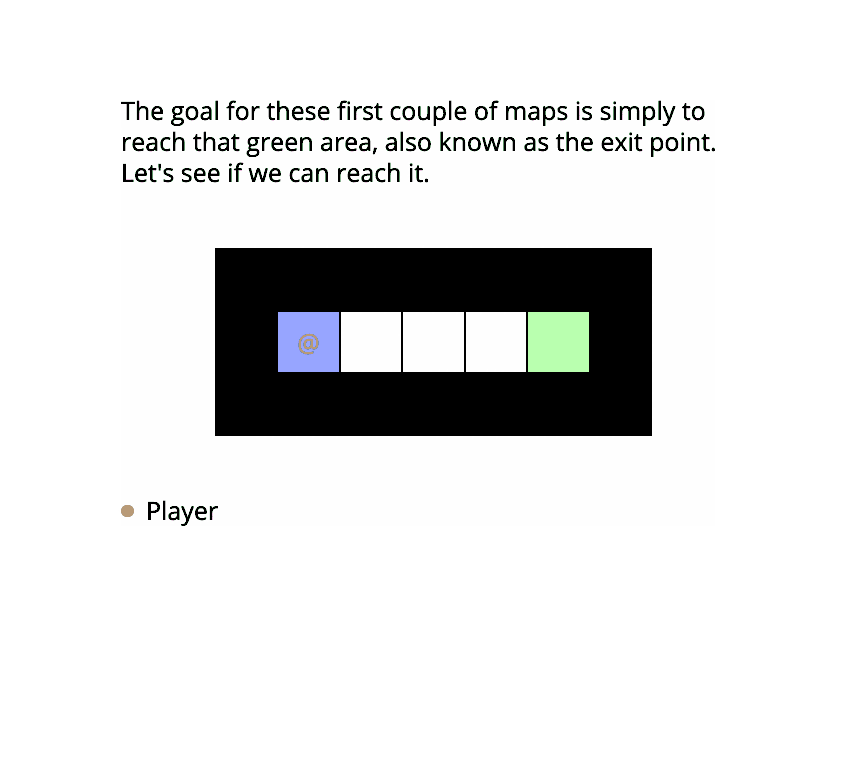
Our warrior managed to complete in a swift dash levels four, five, six and seven!
Level VIII
We are stuck here now.
We have met an enemy, exciting! Let’s add another option to Exploration:
type Exploration
= Freedom
| Enemy
| CanMove Int
| NoGoThen follow some type errors to fix a missing branch in the case statement
within our compareExploration function:
compareExploration : Exploration -> Exploration -> Order
compareExploration first second =
if first == second then
EQ
else
case ( first, second ) of
( Freedom, _ ) ->
LT
( Enemy, _ ) ->
LT
( CanMove x, CanMove y ) ->
compare x y
( CanMove _, NoGo ) ->
LT
( CanMove _, _ ) ->
GT
( NoGo, _ ) ->
GTThen, when we meet another warrior in our path we can attack them!
exploreDirection dir =
case Map.look dir warrior map of
( newCoords, Empty ) :: _ ->
( CanMove (visitedCount newCoords)
, Warrior.Move dir
)
( newCoords, SpawnPoint ) :: _ ->
( CanMove (visitedCount newCoords)
, Warrior.Move dir
)
( newCoords, Warrior _) :: _ ->
( Enemy
, Warrior.Attack dir
)
( _, Exit ) :: _ ->
( Freedom
, Warrior.Move dir
)
_ ->
( NoGo
, Warrior.Wait
)Success! 🎉
Level IX
Let’s check this out.
Now, this is a tricky one. We’re facing a guard that’s much stronger than us. If we remain in the same spot and keep exchanging blows, we’ll die!
As the level suggests, when we notice we’re not feeling well, we can try to heal:
{-| Get the health of a warrior.
-}
health : Warrior -> Int
{-| Get the maximum health the warrior can have.
The warrior will start a map with this much health.
-}
maxHealth : Warrior -> IntThe issue is that if we try to heal while standing near the enemy, it will keep attacking us, ultimately leading to our ghastly demise.
Let’s do a bit of refactoring first: we’re going to split up our takeTurn
function into a couple of smaller functions:
allDirections : List Direction
allDirections =
[ Right, Down, Left, Up ]
exploreDirection :
Warrior
-> Map
-> History
-> Direction
-> ( Exploration, Warrior.Action )
exploreDirection warrior map history dir =
let
visitedCount coords =
History.previousStates warrior history
|> List.filter
(\( w, _ ) ->
Warrior.position w == coords
)
|> List.length
in
case Map.look dir warrior map of
( newCoords, Empty ) :: _ ->
( CanMove (visitedCount newCoords)
, Warrior.Move dir
)
( newCoords, SpawnPoint ) :: _ ->
( CanMove (visitedCount newCoords)
, Warrior.Move dir
)
( newCoords, Warrior _ ) :: _ ->
( Enemy
, Warrior.Attack dir
)
( _, Exit ) :: _ ->
( Freedom
, Warrior.Move dir
)
_ ->
( NoGo
, Warrior.Wait
)
takeTurn : Warrior -> Map -> History -> Warrior.Action
takeTurn warrior map history =
allDirections
|> List.map (exploreDirection warrior map history)
|> List.sortWith
(\( a, _ ) ( b, _ ) -> compareExploration a b)
|> List.head
|> Maybe.map Tuple.second
|> Maybe.withDefault Warrior.WaitNow we can add a function to check if an enemy is nearby:
isEnemyNearby : Warrior -> Map -> Bool
isEnemyNearby warrior map =
allDirections
|> List.any
(\dir ->
case Map.look dir warrior map of
( _, Warrior _ ) :: _ ->
True
_ ->
False
)And another one to tell if our warrior has been wounded:
isWounded : Warrior -> Bool
isWounded warrior =
Warrior.health warrior < Warrior.maxHealth warriorIn our exploreDirection function, when we meet another warrior we
can decide if we’re in a fighting mood:
exploreDirection warrior map history dir =
case Map.look dir warrior map of
( newCoords, Warrior _ ) :: _ ->
if isWounded warrior then
( NoGo
, Warrior.Wait
)
else
( Enemy
, Warrior.Attack dir
)
-- loads of other case branchesAnd inside takeTurn:
takeTurn : Warrior -> Map -> History -> Warrior.Action
takeTurn warrior map history =
if not (isEnemyNearby warrior map) && isWounded warrior then
Warrior.Heal
else
allDirections
|> List.map (exploreDirection warrior map history)
|> List.sortWith
(\( a, _ ) ( b, _ ) -> compareExploration a b)
|> List.head
|> Maybe.map Tuple.second
|> Maybe.withDefault Warrior.WaitWhat happens now?
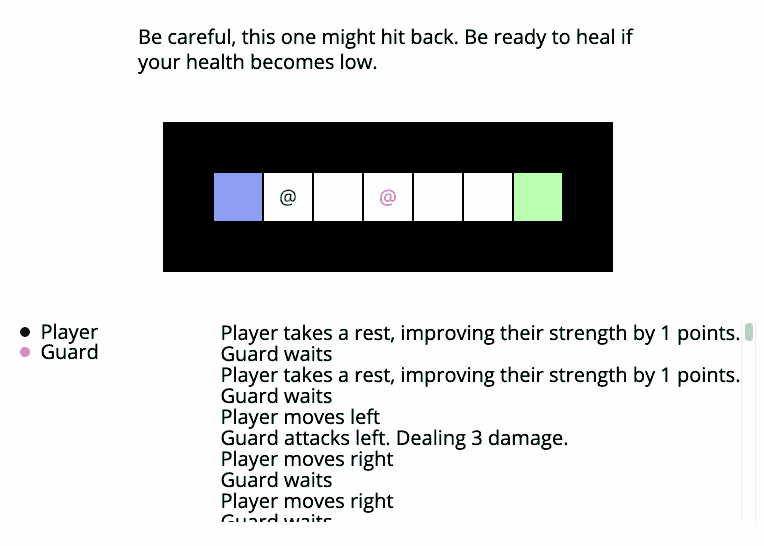
Turns out that as soon as we move near the other warrior, we get attacked. Therefore, we immediately run away to heal, then try again, then run away again. I’m a pacifist at heart, but still I’d like to pass this level.
What’s the solution this time? To endure a little bit of pain…
Instead of running away as soon as we get slightly wounded, we can keep fighting for a bit and only run away when we’re badly wounded.
isBadlyWounded : Warrior -> Bool
isBadlyWounded warrior =
Warrior.health warrior < Warrior.maxHealth warrior // 4Now, we’re going to replace isWounded inside exploreDirection. We
still want the original function inside takeTurn because we want to heal
back to full health when we’re safe.
exploreDirection warrior map history dir =
case Map.look dir warrior map of
( newCoords, Warrior _ ) :: _ ->
if isBadlyWounded warrior then
( NoGo
, Warrior.Wait
)
else
( Enemy
, Warrior.Attack dir
)
-- loads of other case branchesVictory! 🎊
Level X
We’re here now.
Ooh, items! Let’s go and grab them 🏴☠️
We’ll need to add a new branch in the case statement in exploreDirection:
( newCoords, Item _ ) :: _ ->
( CanMove (visitedCount newCoords)
, Warrior.Move dir
)And change our takeTurn function to pickup the item if we are standing on
it:
case
( isEnemyNearby warrior map
, isWounded warrior
, Map.lookDown warrior map
)
of
( False, True, _ ) ->
Warrior.Heal
( _, _, Item _ ) ->
Warrior.Pickup
_ ->
allDirections
|> List.map (exploreDirection warrior map history)
|> List.sortWith
(\( a, _ ) ( b, _ ) -> compareExploration a b)
|> List.head
|> Maybe.map Tuple.second
|> Maybe.withDefault Warrior.WaitThese changes will get us through both levels ten and eleven!
One more thing…
On the last level we can notice something a bit weird:
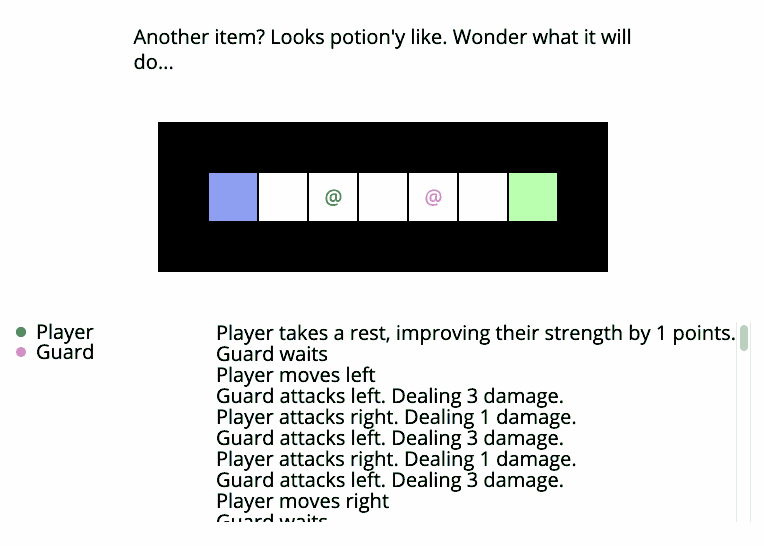
After we run away from the fight and we heal ourselves to full health we start doing a weird left and right dance on the first two tiles. Why is that?
It turns out we have a small bug in our visitedCount helper:
visitedCount coords =
History.previousStates warrior history
|> List.filter
(\( w, _ ) ->
Warrior.position w == coords
)
|> List.lengthSince we spend many turns healing, we end up having a lot of states in our history where the position of the warrior is the same, which ends up inflating the number of times we have “visited” that tile. The fix is to only consider the position of the warrior when it’s moving:
visitedCount coords =
History.previousStates warrior history
|> List.foldr
(\elem acc ->
if List.head acc == Just elem then
acc
else
elem :: acc
)
[]
|> List.filter
(\( w, _ ) ->
Warrior.position w == coords
)
|> List.lengthWith our final fix in place, it’s showtime!

Thanks for reading! 👋
